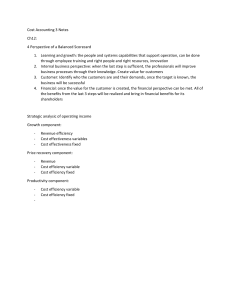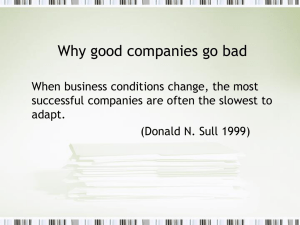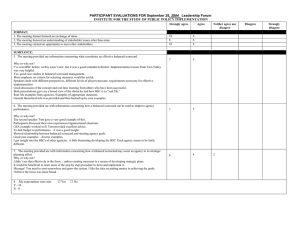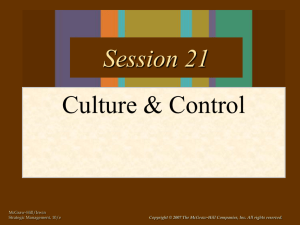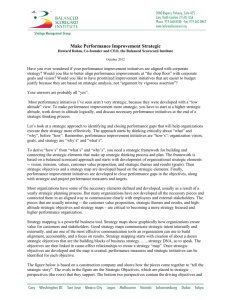Balanced Scorecard Analysis
advertisement
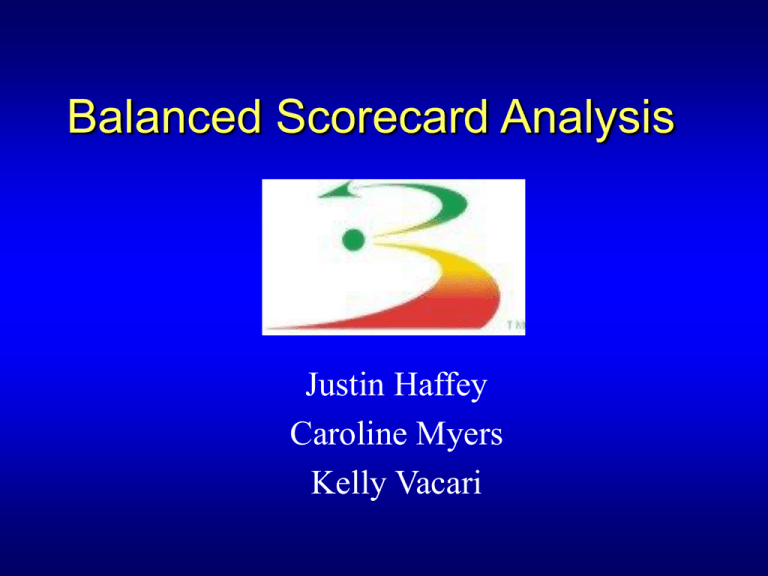
Balanced Scorecard Analysis Justin Haffey Caroline Myers Kelly Vacari A new approach to strategic management Developed in early 1990 by Dr. Robert Kaplan and Dr. David Norton. Was developed because traditional financial measures were inadequate. What is the Balanced Scorecard? The balanced scorecard is a management system that enables organizations to clarify their vision and strategy and translate them into action. It provides feedback around both the internal business process and external outcomes. Four components of Balanced Scorecard Learning and Growth Perspective Business Process Perspective Customer Perspective Financial Perspective Learning and Growth Perspective An organization's ability to innovate, improve, and learn ties directly to its value as an organization. How can we continue to improve and create value for our services? Business Process Perspective Must focus on critical internal operations that enable the organization to satisfy customer needs. To satisfy our shareholders, what business processes must we excel at? Customer Perspective Must know if their organization is satisfying customer needs. To achieve our vision, how should we appear to our customers? Financial Perspective In the private sector, measure typically focused on profit and market share. To succeed financially, how do we appear to our shareholders? Double Feedback Loop The balanced scorecard incorporates feedback around internal business process outputs, as in TQM, but also a feedback around the outcomes of business strategies Outcomes Metric Metrics provide a factual basis for defining: – Strategic feedback to show the present status of – – – – the organization. Diagnostic feedback into various processes to guide improvements. Trends in performance over time. Feedback around the measurement methods themselves Quantitative inputs to forecasting methods for decision support systems Tie to Employee Performance A balanced approach to employee performance appraisal allows management to get a complete look at their performance. Managers are able to provide information needed to align employee performance plans with organizational goals. Balanced Scorecard Adopters Non-Profit Organizations: – Vinfen Corporation – Private Schools Government Organizations: – – – – Federal Aviation Administration Department of Energy United Postal Service Colleges and Universities Adopters Continued Commercial Organizations: – Southwest Airlines – IBM – Pfizer – Ford Motor Company FAA Logistics Center Financial Strategy 1: Increase revenue and margin. Strategy 2: Achieve a return on investment for new systems Strategy 3: Decrease or stabilize core product prices. Customer Strategy 1: Increase customer satisfaction. Strategy 2: Increase Quality Ratings. Strategy 3: Increase customer support to enhance system availability. Internal Processes Mission: Strategy 1: Increase the number of projects organically supported. Grow the Logistics Center as a provider of choice for aviation-related equipment through re-engineering, repair, and supply chain management of future and legacy systems. Strategy 2: Improve product delivery processes and systems. Learning & Growth Strategy 1: Develop workforce strategies that will identify and train to competencies. Strategy 2: Integrate an automated warehouse management system. Strategy 3: Improve internal cost analysis processes. Conclusion The Balanced Scorecard Analysis is very beneficial to an organization. It enables executives to truly execute their strategies. Any Questions??
